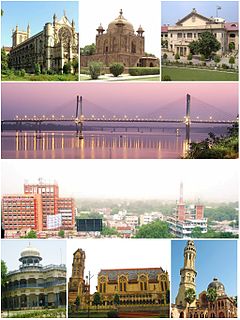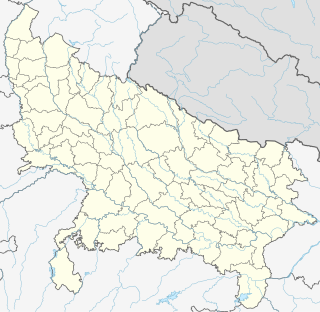
The Yamuna, is the second-largest tributary river of the Ganga and the longest tributary in India. Originating from the Yamunotri Glacier at a height of 6,387 metres (20,955 ft) on the southwestern slopes of Banderpooch peaks of the Lower Himalaya in Uttarakhand, it travels a total length of 1,376 kilometres (855 mi) and has a drainage system of 366,223 square kilometres (141,399 sq mi), 40.2% of the entire Ganga Basin. It merges with the Ganga at Triveni Sangam, Prayagraj, which is a site of the Kumbh Mela, a Hindu festival held every 12 years.

Agra is a city on the banks of the Yamuna river in the Indian state of Uttar Pradesh. It is 206 kilometres (128 mi) south of the national capital New Delhi. Agra is the fourth-most populous city in Uttar Pradesh and 24th in India.

Mirzapurpronunciation (help·info) is a city in Uttar Pradesh, India, roughly 650 km from both Delhi and Kolkata, almost 84 km from Allahabad and 59 km from Varanasi. It is known for its carpets and brassware industries. The city is surrounded by several hills and is the headquarters of Mirzapur district. It is famous for the holy shrine of Vindhyachal, Ashtbhuja and Kali khoh and also Devrahwa Baba ashram. It has many waterfalls and natural spots.
The Karmanasa River is a tributary of the Ganges. It originates in Kaimur district of Bihar and flows through the Indian states of Uttar Pradesh and Bihar. Along the boundary between Uttar Pradesh and Bihar it has the districts of Sonbhadra, Chandauli, Varanasi and Ghazipur on its left ; and the districts of Kaimur and Buxar on its right.

The Vindhya Range is a complex, discontinuous chain of mountain ridges, hill ranges, highlands and plateau escarpments in west-central India.

Orchha is a town in Niwari district of Madhya Pradesh state, India. The town was established by Rudra Pratap Singh some time after 1501, as the seat of an eponymous former princely state of covering parts of central & north India, in the Bundelkhand region. Orchha lies on the Betwa River, 80 km from Tikamgarh & 15 km from Jhansi in Uttar Pradesh.

Sonbhadra or Sonebhadra is the second-largest district by area of Uttar Pradesh, India. Sonbhadra is the only district in India which borders four states namely Madhya Pradesh in west, Chhattishgarh in south, Jharkhand in south east and Bihar in the northeast. The district has an area of 6788 km² and a population of 1,862,559, with a population density of 270 persons per km². It lies in the extreme southeast of the state, and is bounded by Mirzapur District to the northwest, Chandauli District to the north, Kaimur and Rohtas districts of Bihar state to the northeast, Garhwa district of Jharkhand state to the east, Balrampur District of Chhattisgarh state to the south, and Singrauli district of Madhya Pradesh state to the west. The district headquarters is in the town of Robertsganj.
Vindhyachalpronunciation (help·info) is a city in Mirzapur District of the Indian state of Uttar Pradesh. The city is a Hindu pilgrimage site having the temple of Vindhyavasini, who according to Markandeya Purana had incarnated to kill the demon Mahishasura. The detailed description has been given in 'Durga Saptashati' Chapter of Markandeya Purana. The river Ganga flows through this city. The Indian Standard Time (IST) line passes through the Vindhyachal railway station.

Varanasi division is an administrative geographical unit of Uttar Pradesh state of India. Varanasi is the administrative headquarters of the division. Currently (2018), the division consists of districts of Varanasi, Chandauli, Ghazipur, and Jaunpur and is loosely equivalent to the Benares State.

Jaunpur district is a district in the Varanasi Division of the Indian state of Uttar Pradesh. The district headquarters is Jaunpur which is situated on the banks of the Gomti River. It is located 228 km southeast of the state capital Lucknow. The district has two Lok sabha seats and nine Vidhan Sabha seats. According to the 2011 census, Jaunpur has a gender ratio of 1,024 females to 1,000 males, the highest in Uttar Pradesh. The main languages are Hindi, Urdu, Awadhi and Bhojpuri.

Mirzapur district is one of the 75 districts of Uttar Pradesh state in northern India. The district is bounded on the north by Bhadohi and Varanasi districts, on the east by Chandauli district, on the south by Sonbhadra district and on the northwest by Allahabad. The district occupies an area of 4521 km2. Mirzapur city is the district headquarters. Mirzapur district is a part of Mirzapur division. This district is known for the Vindhyavasini temple in Vindhyachal and several tourist attractions like water falls like Rajdari & Devdari and dams. It consist of several Ghats where historical sculptures are still present. During the Ganges festival these Ghats are decorated with lights and diyas. It is a part of the Red Corridor.

Satna District is a district of Madhya Pradesh state in central India. The City of Satna is the district headquarters. The district has an area of 7,502 km², and a population of 2,228,935(2011 census), 20.63% of which is urban. The district has a population density of 249 persons per km².

Allahabad, officially known as Prayagraj, and also known as Illahabad and Prayag, is a city in the Indian state of Uttar Pradesh. It is the administrative headquarters of Allahabad district—the most populous district in the state and 13th most populous district in India—and the Allahabad division. The city is the judicial capital of Uttar Pradesh with Allahabad High Court being the highest judicial body in the state. As of 2011, Allahabad is the seventh most populous city in the state, thirteenth in Northern India and thirty-sixth in India, with an estimated population of 1.11 million in the city and 1.21 million in its metropolitan region. In 2011 it was ranked the world's 40th fastest-growing city. Allahabad, in 2016, was also ranked the third most liveable city in the state and sixteenth in the country. Hindi is the most widely spoken language in the city.
The economy of Uttar Pradesh is the fifth largest of all the states of India. According to the state budget for 2017–18, Uttar Pradesh's gross state domestic product is ₹16.89 lakh crore (US$240 billion). The largest Indian state, Maharashtra on the basis of nominal GDP, has an urban population of 50,818,259, while Uttar Pradesh has an urban population of 44,495,063. According to the 2011 census report, 22.76% of Uttar Pradesh's population lives in urban areas. The state has 7 cities with populations exceeding 1 million each. After partition in 2000, the new Uttar Pradesh state produces about 92% of the economic output of the old Uttar Pradesh state. In 2011, the Tendulkar committee reported that 29.43% of Uttar Pradesh's population is poor, while the Rangarajan committee reported that 39.8% of the population is poor.

Kaimur Range is the eastern portion of the Vindhya Range, about 483 kilometres (300 mi) long, extending from around Katangi in Jabalpur district of Madhya Pradesh to around Sasaram in Rohtas district of Bihar. It passes through the Rewa and Mirzapur divisions. The range never rises more than a few hundred metres above the surrounding plains and has a maximum width of around 80 km.

The Baheliya are a Hindu caste found in the state of Uttar Pradesh, India.

Chhitampatti is a small village at the bank of river Ganga at the Mirzapur district of Uttar Pradesh, India. The main settlers of this village are Brahmins. This village is 12 km north-east to Mirzapur district headquarters.

The Chunar Fort is located in Mirzapur district of Uttar Pradesh, in India. Along with Chunar town, situated below the fort, the two are historic places with common history and legends. It is located 23 kilometres (14 mi) south west of Varanasi. The southeastern part of the fort is on the rocky bank of the Ganges River. The fort's history spans from 56 BC and then between Afghan decedent Sher Shah Suri's (1532) rule, the Mughal Empire rule up to 1772, and finally the British Raj up to 1947 till India gained independence. Chunar railway station is on the Mughalsarai-Kanpur section of Howrah-Delhi main line.
Kamariya is a sub-caste of Ahir Community.
The Nanwag Rajputs are a branch of the Kachwaha Rajput community in what is now the Indian state of Uttar Pradesh. In the 16th century, they seized a portion of Pandrah pargana and ruled there for many years before losing it to a Punjabi and Brahmans. The villages of Kathiraon, Newarhia lying at 25" 31' N longitude and 82" 80' E latitude and Barsathi, latitude 25" 34' N and longitude 82" 91' E in Mariahu tehsil, were administered by the Nanwag Rajputs from the 16th century to the later part of the 19th century. The whole of Mariahu tehsil was administered by them during the medieval period and the tehsil got its name from Mandav Dev, the presiding deity of Nanwags.
















